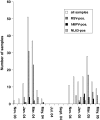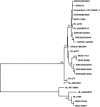Detection of human coronavirus NL63, human metapneumovirus and respiratory syncytial virus in children with respiratory tract infections in south-west Sweden
- PMID: 17002608
- PMCID: PMC7128111
- DOI: 10.1111/j.1469-0691.2006.01506.x
Detection of human coronavirus NL63, human metapneumovirus and respiratory syncytial virus in children with respiratory tract infections in south-west Sweden
Abstract
Two recently detected viruses, human metapneumovirus (hMPV) and coronavirus NL63 (HCoV-NL63), have been associated with acute respiratory tract infections, particularly in young children. This study investigated the frequency of hMPV and HCoV-NL63 infections in Swedish children by screening 221 nasopharyngeal aspirates, collected between November 2003 and May 2005, from 212 children attending the paediatric department of a county hospital in Sweden or submitted from local general practitioners. The samples were originally submitted to be tested for respiratory syncytial virus (RSV), and were examined retrospectively for hMPV and HCoV-NL63 by RT-PCR. Of the 212 patients, 101 were positive for RSV (48%), 22 (10%) were positive for hMPV, and 12 (6%) were positive for HCoV-NL63. The frequency of HCoV-NL63 infection increased from 1% in 2003-2004 to 10% in 2004-2005. Sequence analysis of parts of the coronavirus genomes showed considerable similarity to the HCoV-NL63 prototype sequence. The study demonstrated that HCoV-NL63 and hMPV occur in south-west Sweden with essentially the same frequency, seasonal distribution and clinical characteristics as have been reported in other countries.
Figures



Similar articles
-
Coronavirus causes lower respiratory tract infections less frequently than RSV in hospitalized Norwegian children.Pediatr Infect Dis J. 2011 Apr;30(4):279-83. doi: 10.1097/INF.0b013e3181fcb159. Pediatr Infect Dis J. 2011. PMID: 21057374
-
Two-year prospective study of single infections and co-infections by respiratory syncytial virus and viruses identified recently in infants with acute respiratory disease.J Med Virol. 2008 Apr;80(4):716-23. doi: 10.1002/jmv.21108. J Med Virol. 2008. PMID: 18297694 Free PMC article.
-
Role of human metapneumovirus, human coronavirus NL63 and human bocavirus in infants and young children with acute wheezing.J Med Virol. 2008 May;80(5):906-12. doi: 10.1002/jmv.21135. J Med Virol. 2008. PMID: 18360904 Free PMC article.
-
Human metapneumovirus: a newly emerging respiratory pathogen.Curr Opin Infect Dis. 2003 Jun;16(3):255-8. doi: 10.1097/00001432-200306000-00012. Curr Opin Infect Dis. 2003. PMID: 12821817 Review.
-
Human metapneumovirus (hMPV) in 2025: emerging trends and insights from community and hospital-based respiratory panel analyses-a comprehensive review.Virol J. 2025 May 20;22(1):150. doi: 10.1186/s12985-025-02782-y. Virol J. 2025. PMID: 40394641 Free PMC article. Review.
Cited by
-
Deletion of human metapneumovirus M2-2 increases mutation frequency and attenuates growth in hamsters.Virol J. 2008 Jun 3;5:69. doi: 10.1186/1743-422X-5-69. Virol J. 2008. PMID: 18519001 Free PMC article.
-
Human Coronavirus NL63 Molecular Epidemiology and Evolutionary Patterns in Rural Coastal Kenya.J Infect Dis. 2018 May 5;217(11):1728-1739. doi: 10.1093/infdis/jiy098. J Infect Dis. 2018. PMID: 29741740 Free PMC article.
-
Nucleic acid amplification tests for detection of respiratory viruses.J Clin Virol. 2007 Nov;40 Suppl 1:S15-23. doi: 10.1016/S1386-6532(07)70005-7. J Clin Virol. 2007. PMID: 18162249 Free PMC article. Review.
-
Origins and Evolution of Seasonal Human Coronaviruses.Viruses. 2022 Jul 15;14(7):1551. doi: 10.3390/v14071551. Viruses. 2022. PMID: 35891531 Free PMC article.
-
Systematic assembly of a full-length infectious clone of human coronavirus NL63.J Virol. 2008 Dec;82(23):11948-57. doi: 10.1128/JVI.01804-08. Epub 2008 Sep 25. J Virol. 2008. PMID: 18818320 Free PMC article.
References
-
- Henrickson KJ. Advances in the laboratory diagnosis of viral respiratory disease. Pediatr Infect Dis J 2004; 23: S6–S10. - PubMed
-
- Sinaniotis CA. Viral pneumoniae in children: incidence and aetiology. Paediatr Respir Rev 2004; 5 (suppl A): S197–S200. - PubMed
-
- Claesson BA, Trollfors B, Brolin I et al. Etiology of community‐acquired pneumonia in children based on antibody responses to bacterial and viral antigens. Pediatr Infect Dis J 1989; 8: 856–862. - PubMed
-
- Juven T, Mertsola J, Waris M et al. Etiology of community‐acquired pneumonia in 254 hospitalized children. Pediatr Infect Dis J 2000; 19: 293–298. - PubMed
-
- Michelow IC, Olsen K, Lozano J et al. Epidemiology and clinical characteristics of community‐acquired pneumonia in hospitalized children. Pediatrics 2004; 113: 701–707. - PubMed
Publication types
MeSH terms
LinkOut - more resources
Full Text Sources
Medical

